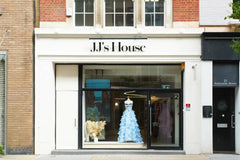
The Shift from Ownership to Experience: Understanding Luxury Brand Evolution in China
Table of Contents
- Key Highlights:
- Introduction
- Experience Over Possession
- Immediacy as a Response to Risk
- The Louis: Spectacle or Sales Catalyst?
- Experience or Product: A Balance to Be Found
- What Makes The Louis Different: The Winning Hybridization
- Competitive Comparison: A More Structured Hybridization
- Game Theory Applied to Luxury Experiential Strategies
- Towards Profitable Luxury Emotion?
Key Highlights:
- Luxury consumers in China are increasingly prioritizing experiences over material possessions, leading to a significant decline in spending on personal luxury goods.
- Initiatives like Louis Vuitton's flagship store, "The Louis," exemplify the shift towards experiential retail, blending shopping with immersive experiences to cultivate brand loyalty.
- The hybrid model employed by luxury brands aims to balance immediate sales with long-term customer engagement, leveraging social media and experiential marketing to enhance brand visibility and emotional connection.
Introduction
The luxury market, long characterized by its emphasis on material possessions and status symbols, is undergoing a profound transformation, particularly in China. Recent economic pressures have prompted consumers to reevaluate their spending habits, shifting their focus from acquiring goods to seeking memorable experiences. This change is not merely a fleeting trend; it reflects a fundamental reorientation of consumer values and brand engagement in a landscape shaped by social media and a desire for authenticity. As brands adapt to this new reality, the effectiveness of experiential initiatives, such as Louis Vuitton's "The Louis," raises critical questions about the future of luxury retail.
Experience Over Possession
The evolution of consumer behavior in China illustrates a significant pivot within the luxury sector. According to Bain & Company, personal luxury goods spending in China plummeted by 18 to 20 percent in 2023, signifying a broader shift in consumer priorities amid economic uncertainty. The decline in demand is not indicative of a rejection of luxury but rather a transformation in desire. Consumers are gravitating towards experiences—whether travel, dining, or wellness—over material acquisitions, reflecting a deeper trend of valuing shared moments and collective memories.
This shift is encapsulated by a comment from a Prada customer who stated, "I no longer buy stuff," highlighting a movement towards experiential consumption. The emphasis now lies on the symbolic value of experiences, fostering a sense of belonging within brand communities rather than mere ownership of luxury items. This trend is especially pronounced among younger generations, who prioritize emotional connections and social sharing over traditional notions of status.
Immediacy as a Response to Risk
The rapid pace of change in market tastes and economic conditions has made luxury consumers more cautious about their investments. High-priced luxury items now come with risks of obsolescence, as styles can quickly fall out of favor. This has led to a preference for experiences that are transient yet meaningful, as moments shared with friends or family can never go out of style.
By focusing on experiences rather than products, brands can offer intangible value that resonates emotionally with consumers. This aligns with the preferences of Gen Z and Millennials, who prioritize story-value over use-value, as evidenced by spending patterns that show a rise in immersive experiences, even as traditional luxury goods face declining sales.
Bain & Company reported a 5 percent increase in spending on experiences like dining and travel in 2024, contrasting with the decline in luxury goods. For luxury brands, this shift presents a dual challenge: creating experiences that resonate with consumers while maintaining profitability in a market increasingly focused on intangible assets.
The Louis: Spectacle or Sales Catalyst?
Louis Vuitton's flagship store, "The Louis," located in Shanghai, epitomizes the brand's response to these shifting consumer dynamics. Designed as a hybrid space that includes a traditional retail store, café, and exhibition area, The Louis aims to captivate visitors and generate buzz rather than immediate sales.
While the store has successfully attracted large crowds and garnered significant media attention, translating this visibility into substantial sales remains a challenge. Customers often express that the experience feels different, even if it does not directly lead to purchases. This reflects the broader trend where luxury brands focus on creating memorable experiences that enhance brand equity rather than just driving immediate revenue.
The decline in sales for LVMH in the Asia-Pacific region underscores the urgency for luxury brands to adapt. With a notable drop in spending among Chinese consumers, brands are faced with the necessity of strategic pricing and marketing adjustments to remain competitive in a volatile environment.
Experience or Product: A Balance to Be Found
Luxury brands must navigate the delicate balance between experiential marketing and product sales. While experiential initiatives may not yield immediate financial returns, they serve as crucial platforms for long-term customer acquisition and loyalty. By creating engaging environments, brands can collect valuable consumer data and activate word-of-mouth marketing.
Experiential spaces like cafés and exhibitions not only enhance brand visibility but also fill the sales funnel by attracting new audiences who may not typically engage with traditional luxury retail formats. This strategy is particularly effective among younger consumers and those who may be "occasional" luxury shoppers.
What Makes The Louis Different: The Winning Hybridization
Louis Vuitton's strategy with The Louis showcases a well-rounded approach to experiential retail. The flagship store aims to maximize customer engagement by blending elements of spectacle, culture, and shopping into a cohesive experience.
Iconic Architecture and Buzz Catalyst
Towering at 30 meters on Nanjing Road, The Louis serves as a striking architectural landmark that captures attention and generates buzz. Its design invites visitors to engage with the brand visually and emotionally, creating a narrative that extends beyond mere shopping.
The store's visual appeal is a key driver of social media engagement, as customers share their experiences online, further amplifying the brand's presence in the digital landscape.
Mixed Content and Emotional Immersion
Inside The Louis, the design encourages exploration and emotional connection. The space features ephemeral exhibitions and themed cafés, inviting visitors to partake in a journey that transcends traditional retail experiences. This immersive approach cultivates a strong emotional bond with the brand, transforming visitors into ambassadors who share their experiences with others.
Sophisticated Targeting and Controlled Viralization
The activation strategy for The Louis is carefully crafted to target ultra-high-net-worth individuals and influential figures within the luxury space. By focusing on key opinion leaders, Louis Vuitton enhances its brand narrative and ensures that its message reaches the right audience organically.
The store's design fosters a seamless journey that encourages online research and in-store purchases, capitalizing on the trend of consumers using digital platforms to inform their shopping decisions.
Alignment and Power of Social Commerce
Social commerce plays a pivotal role in luxury retail, particularly in the Chinese market. With a significant portion of e-commerce driven by platforms that incorporate live shopping and social media engagement, luxury brands must integrate these channels into their strategies.
The Louis aligns closely with the growing demand for experiential luxury, focusing on creating memorable moments that resonate with consumers. This approach not only enhances brand loyalty but also drives conversion through data collected from customer interactions.
Competitive Comparison: A More Structured Hybridization
While several luxury brands are exploring experiential avenues, The Louis distinguishes itself through its comprehensive and integrated approach. Other initiatives, such as the Prada Rong Zhai and the Dior Cafés, focus on specific aspects of experiential retail but often lack the same level of strategic coherence.
The Louis, however, integrates various elements—cultural experiences, dining, and retail—into a singular narrative designed to optimize customer engagement. This holistic approach allows for a more fluid customer journey, addressing the complexities of a rapidly evolving luxury market.
Game Theory Applied to Luxury Experiential Strategies
The competitive landscape of luxury retail can be analyzed through the lens of game theory, where brands adjust their strategies based on the moves of their competitors. Three primary strategies can be identified: traditional sales, pure experiential approaches, and hybrid models.
- Traditional Sales focus on direct product sales, offering high margins but limited customer acquisition potential.
- Pure Experiential initiatives prioritize brand image and engagement, often yielding low ROI but attracting new audiences.
- Hybrid Approaches—like that of The Louis—combine elements of both, balancing acquisition and activation with storytelling to create a more robust customer experience.
The strategic dilemma for luxury brands lies in finding the right balance between spectacle and substance. A market saturated with pure experiential initiatives risks losing its distinctiveness, while an overreliance on traditional sales could alienate younger consumers who crave engagement and storytelling.
Towards Profitable Luxury Emotion?
In a more selective Chinese market, immersive experiences are not just an alternative but a critical lever for brand activation and loyalty. By fostering desire rather than pushing for immediate sales, The Louis aims to embed itself in the collective imagination of consumers, ultimately influencing their future purchasing decisions.
This strategic approach seeks to build a solid foundation for the brand while leveraging digital tools to enhance customer engagement. Social commerce, ROPO strategies, and enriched CRM systems play a vital role in transforming emotional connections into tangible sales of high-value luxury products.
The Louis exemplifies a significant trend in luxury retail: the shift from transactional relationships to experiential engagement. The act of purchasing has evolved into the culmination of a narrative, where the experience itself becomes a defining aspect of brand loyalty.
FAQ
Q: Why are luxury consumers shifting from products to experiences?
A: Economic pressures and changing values have led consumers, especially younger generations, to prioritize shared experiences over material possessions, seeking emotional connections and memorable moments.
Q: How does experiential retail benefit luxury brands?
A: Experiential retail enhances brand visibility, fosters emotional connections with consumers, and can drive long-term customer loyalty, even if immediate sales are not achieved.
Q: What is The Louis, and why is it significant?
A: The Louis is Louis Vuitton's flagship store in Shanghai, designed as a hybrid space that combines shopping, dining, and immersive experiences, reflecting the brand's adaptation to shifting consumer preferences.
Q: How do luxury brands measure the success of experiential initiatives?
A: Success is often measured through customer engagement, foot traffic, social media buzz, and the collection of consumer data, which can lead to increased sales over time.
Q: What role does social commerce play in luxury retail?
A: Social commerce facilitates conversion through engaging content and live shopping experiences, making it a critical component of modern luxury marketing strategies, particularly in markets like China.
당신의 전자상거래를 우리의 주간 통찰력과 업데이트로 강화하세요!
상거래 세계에서 일어나는 일에 대한 정보를 계속 업데이트하세요
이메일 주소





